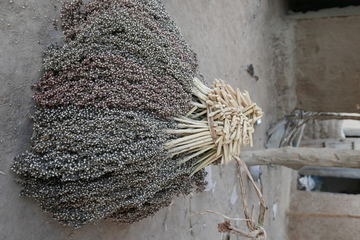Feed
-
Natural plant productsNatural plant products have been used throughout human history forvarious purposes. Having co-evolved with animal life, many of the plants fromwhich these natural products are derived are billions of years old. Tens ofthousands of these products are produced and discovered since. Dyes areone of them. Fabric dye has been one of the common things used in these moderndays. But using it has also disadvantages to the environment. Therun-offfrom fabric dye pollutes water ways, and the dyes themselves are not sohealthy for workers who are around them day in and day out, either.There areways to prevent these harmful effects of using dye to both the environmentand human beings, and that is by using organic substances instead ofcommercialized products which utilizes toxic ingredients.By: rupaliWednesday, Jun 9, 2021AGRI-FOOD SYSTEMS+1

-
Lorem Ipsum: Where does it come from?Contrary to popular belief, Lorem Ipsum is not simply random text. It has roots in a piece of classical Latin literature from 45 BC, making it over 2000 years old. Richard McClintock, a Latin professor at Hampden-Sydney College in Virginia, looked up one of the more obscure Latin words, consectetur, from a Lorem Ipsum passage, and going through the cites of the word in classical literature, discovered the undoubtable source. Lorem Ipsum comes from sections 1.10.32 and 1.10.33 of "de Finibus Bonorum et Malorum" (The Extremes of Good and Evil) by Cicero, written in 45 BC. This book is a treatise on the theory of ethics, very popular during the Renaissance. The first line of Lorem Ipsum, "Lorem ipsum dolor sit amet..", comes from a line in section 1.10.32. The standard chunk of Lorem Ipsum used since the 1500s is reproduced below for those interested. Sections 1.10.32 and 1.10.33 from "de Finibus Bonorum et Malorum"By: Edwin CastelFriday, May 21, 2021EDUCATION

-
Venture capitalPrimer text from The College of William & MaryADHD is one of the most commonly diagnosed conditions of children (Centers for DiseaseControl and Prevention, 2015). In a 2016 Centers for Disease Control and Prevention study, scientists found that 6.1 million children aged 2-17 years living in the U.S. had been diagnosed with attention-deficit/hyperactivity disorder (ADHD), which is similar to previous estimates. Ages 2-5: Approximately 388,000 children Ages 6-11: Approximately 2.4 million children Ages 12-17: Approximately 3.3 million children The diagnostic term attention deficit/hyperactivity disorder (ADHD) refers to individuals who display patterns of inattention, impulsivity, and overactive behavior that interfere with daily functioning (American Psychiatric Association [APA], 2013). The Diagnostic and Statistical Manual (DSM) V (APA, 2013) criteria for diagnosing ADHD listthree types of ADHD and the accompanying characteristics. Predominantly inattentive type.The student may:o submit inaccurate or incomplete work,o have difficulty attending to conversations, activities, or tasks,o be easily distracted,o have difficulty following directions,o frequently lose materials, and/oro have difficulty organizing tasks and materials.By: Anne miller New vijayalaxmi santosh mhetre maliWednesday, May 26, 2021CULTURE AND SOCIETY+1

-
Plant sterolsPlant sterols are found in the highest amounts in foods like vegetable oils, nuts, and seeds. Plant sterols are used as medicine. Plant sterols are most commonly used for lowering. Plant sterols are a group of substances made in plants. Plant sterols are found in the highest amounts in foods like vegetable oils, nuts, and seeds. Plant sterols are used as medicine.Plant sterols are most commonly used for lowering cholesterol levels. Plant sterols are also used for other conditions, but there is no good scientific evidence to support these other uses.By: rupaliThursday, May 20, 2021WATER, ENERGY, AND THE ENVIRONMENT+1

-
Regenerative Organic AgricultureRegenerative agriculture is a conservation and rehabilitation approach to food and farming systems. It focuses on topsoil regeneration, increasing biodiversity. Regenerative agriculture is a conservation and rehabilitation approach to food and farming systems. It focuses on topsoil regeneration, increasing biodiversity, improving the water cycle, enhancing ecosystem services, supporting biosequestration, increasing resilience to climate change, and strengthening the health and vitality of farm soil. Regenerative agriculture is an adaptive management approach that is supported by soil health principles. There is no recipe or prescription because each farm or ranch differs based on unique natural resources, climate variability, and animal and ecological dynamics. Regenerative agriculture practices are designed to reduce inputs of synthetic fertilizers and pesticides, increase soil organic matter, enhance biodiversity and restore ecosystems, particularly optimizing the hydrological cycle. While the general public knows little about the crisis of soil loss, there is awareness and concern regarding the climate crisis. The two are connected and the recent surge of interest in regenerative agriculture has been stimulated by the hope of climate resilience and carbon sequestration offered by regenerative agriculture. Climate change mitigation has focused mainly on cutting carbon emissions and replacing fossil fuels with renewable energies. But more recently, carbon sequestration has come into the spotlight. The potential for agricultural practices to draw down and absorb carbon in the soil has begun to receive more attention.By: rupaliWednesday, May 19, 2021AGRI-FOOD SYSTEMS

-
How Sociologists Define CultureCulture is one of the most important concepts within sociology because sociologists recognize that it plays a crucial role in our social lives. It is important for shaping social relationships, maintaining and challenging social order, determining how we make sense of the world and our place in it, and in shaping our everyday actions and experiences in society. It is composed of both non-material and material things. In brief, sociologists define the non-material aspects of culture as the values and beliefs, language, communication, and practices that are shared in common by a group of people. Expanding on these categories, culture is made up of our knowledge, common sense, assumptions, and expectations. It is also the rules, norms, laws, and morals that govern society; the words we use as well as how we speak and write them and the symbols we use to express meaning, ideas, and concepts (like traffic signs and emojis, for example). Culture is also what we do and how we behave and perform (for example, theater and dance). It informs and is encapsulated in how we walk, sit, carry our bodies, and interact with others; how we behave depending on the place, time, and "audience;" and how we express identities of race, class, gender, and sexuality, among others. Culture also includes the collective practices we participate in, such as religious ceremonies, the celebration of secular holidays, and attending sporting events.By: rupaliTuesday, May 18, 2021CULTURE AND SOCIETY+2

-
Human activity affects and Global warming, the phenomenonHuman activity affects global surface temperatures by changing Earth's radiative balance—the “give and take” between what comes in during the day and what Earth emits at night. Increases in greenhouse gases—i.e., trace gases such as carbon dioxide and methane that absorb heat energy emitted from Earth's surface and reradiate it back—generated by industry and transportation cause the atmosphere to retain more heat, which increases temperatures and alters precipitation patterns. Global warming, the phenomenon of increasing average air temperatures near the surface of Earth over the past one to two centuries. Climate scientists have since the mid-20th century gathered detailed observations of various weather phenomena (such as temperatures, precipitation, and storms) and of related influences on climate (such as ocean currents and the atmosphere’s chemical composition).By: rupaliWednesday, May 12, 2021WATER, ENERGY, AND THE ENVIRONMENT+1


Leave a comment